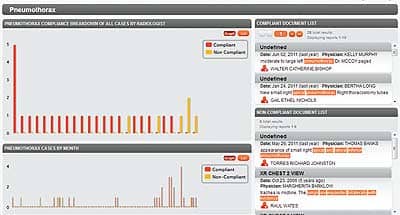Clinical documentation services provider M*Modal recently unveiled the first two applications of its new M*Modal Catalyst cloud-based product line, which looks to improve the quality of patient care by extracting actionable information from unstructured medical documentation.
Stephen Willis, chief information officer of management services firm Canopy Partners, of Greensboro, NC, has gotten to know the M*Modal Catalyst suite, which includes M*Modal Catalyst for Quality and M*Modal Catalyst for Radiology, over the past year. The company had previously been using its interface engine to dig out snippets of text to make sure team members were doing what they wanted to do. For critical findings, radiologists were asked to put in specific verbiage, an automated macro or auto text. At the end of the month, Canopy would then run a report that displayed all the instances where a particular blurb of text existed, and it would pass along the information to its hospital clientele so that they could perform their critical findings tracking.
“We were having to rely on radiologists being nearly perfect not only in just doing the work they were supposed to do but in the language they used,” Willis said. “It was very inefficient with no nuance allowed—a very black-and-white way of pulling a report.”

M*Modal Catalyst for Radiology lets hospitals and practices identify clinical information within their radiology documents.
Canopy realized that it had access to the information around the metadata that surrounded the report, such as the modality used, the subspecialty, the doctor who read it, the patient information, turnaround time, and multiple angles, but it did not have any information from inside the report. Yet, mining that data would greatly improve quality. That’s where Catalyst came into play. “Catalyst basically turned unstructured data, the text of the report, into structured data that we could very simply mine for quality measures,” Willis said.
According to M*Modal, its Catalyst provides visibility and understanding of key clinical concepts that are often left out of traditional documentation, such as patient fall risk factors, dietary practices, and causes of events. As a cloud-based, open solution, the platform allows for flexibility and scalability to an entire enterprise and is vendor-neutral. Moreover, it enables speech recognition and natural language processing in a single contiguous process.
The company has targeted its M*Modal Catalyst for Quality for health care professionals who wish to improve their documentation quality and achieve meaningful use compliance. Meanwhile, M*Modal Catalyst for Radiology lets hospitals and practices identify clinical information within their radiology documents. For Willis, the benefits of Catalyst he particularly enjoys are the ease of writing queries as well as its dashboarding functionality. “Catalyst puts all the business analytics into a user-friendly format,” he said. “Any physician can log on, see the data. and drive around it very easily. It’s as simple as clicking on a bar; it expands out, you can see it by physician, by modality, by exam code, and you can sort it. All that data becomes very meaningful; you get beyond this is what it is to why it is.”
Furthermore, M*Modal recently introduced its M*Modal Fluency family of clinical solutions, which allows hospital users to electronically capture patient stories for reimbursement via its Speech Understanding technology. M*Modal Catalyst drives intelligence from this data, as well as from other medical documents. Willis said Canopy is in the process of converting its Speech Q platform to the new Fluency one; after the transition is complete, radiologists will have access to active feedback as they dictate their reports. For example, if a radiologist mentions a pulmonary nodule in dictation, they will be reminded to include a Fleischner table.
Willis pointed out that medicine as a whole, with radiology at the forefront, is moving toward an accountable care model, from an efficiency and productivity focus to a value and quality focus. “We want to make sure the systems that radiologists use are robust and dependable, so that the actual technology surrounding the physicians is making them more accurate. We want to increase the quality of the patient lives that are affected. This is one of the main keys to that. The ability to give that physician a rich interpretation of their report as they are dictating it is really a game changer for us.”





